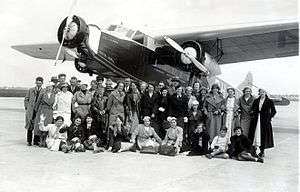Fokker F.XVIII
| F.XVIII | |
|---|---|
 | |
| Role | Airliner |
| Manufacturer | Fokker |
| First flight | 30 June 1932 |
| Primary user | KLM |
| Number built | 5 |
|
| |
The Fokker F.XVIII was an airliner produced in the Netherlands in the early 1930s, essentially a scaled-up version of the Fokker F.XII intended for long-distance flights. Like its predecessor, it was a conventional high-wing cantilever monoplane with fixed tailwheel undercarriage. Its cabin could seat 12 passengers, or four-to-six on seats convertible to sleeping berths. Only five were built, all for KLM, and registered as PH-AIO, 'AIP, 'AIQ, 'AIR and 'AIS, all of which were named after birds. Used by KLM on its Amsterdam-Batavia route, the F.XVIII became celebrated in the Netherlands due to two especially noteworthy flights. In December 1933, one aircraft (registration PH-AIP, Pelikaan - "Pelican") was used to make a special Christmas mail flight to Batavia, completing the round trip in a flight time of 73 hours 34 minutes. The following Christmas, another F.XVIII (registration PH-AIS, Snip - "Snipe") made a similar flight to Curaçao in 55 hours 58 minutes after having been specially re-engined for the journey.
In October 1936, the F.XVIIIs were withdrawn from the service to Batavia, replaced by the Douglas DC-2. KLM sold PH-AIQ and PH-AIR to ČSA where they were re-registered as OK-AIQ and OK-AIR. They used them on their Prague-Vienna-Berlin route until 1938. 'AIQ went to Commercial Aviation Corporation in Palestine in December 1938 where it became VQ-PAF, crashing at Lydda on 13 January 1939. The wreck was later taken on-charge by the Israeli Air Force but never re-built and it was scrapped in Israel after 1948. OK-AIR was taken on-charge by Deutsche Lufthansa in 1938 as D-AAIR.[1] Its fate is unrecorded - probably pressed into Luftwaffe service and destroyed during WW2. PH-AIP Pelikaan went to Air Tropique, a front for the Spanish Republican government which used it as a transport during the Spanish Civil War. It was transferred onto the French register as F-APIP and destroyed by a bombing raid at Vilajuiga, Spain on 6 February 1939. The two remaining aircraft were transferred to KLMWIB (Koninklijke Luchtvaart Maatschappij West-Indisch Bedrijf - KLM's West Indies Division) at Willemstad, Curaçao for regional services in the Caribbean.[2] One of these was PH-AIS Snip, later PJ-AIS, the other was PH-AIO, later PJ-AIO,[3] originally named Oehoe ("Owl"), but renamed Oriol ("Oriole") since the Owl was regarded as unlucky in the local culture. These aircraft served on routes between Curaçao and Venezuela, Dutch Guiana (now Suriname), Columbia and Trinidad as well as inter-island services to Aruba, Bonaire and Sint Maarten. Routes to Jamaica opened in 1941, and Cuba and Miami in 1942.
PJ-AIO was leased to the Netherlands West Indies colonial government in June 1940 and converted by KLM engineers into a maritime patrol aircraft for use by the Netherlands West Indies Defence Force. A single .303 Lewis machine gun was fitted on a flexible mount firing from an open dorsal position. The passenger cabin was stripped out and a bomb-bay installed consisting of racks to hold an unspecified number of improvised 8 kg (80mm) anti-submarine bombs aimed and dropped by hand from an open bombardier's hatch in the bomb bay floor. The aircraft was given a coat of camouflage paint and orange Dutch national markings were applied. No military serial was allocated. The machine was employed on anti-submarine patrol duties from both Oranjestad, Aruba and Hato, Curaçao from 1940 until 1942 when it was returned to KLM civil use, the anti-submarine patrols being taken over by US aircraft.
The two aircraft remained in service until 1946 when PJ-AIO was broken-up at Curaçao. PJ-AIS remained derelict at Willemstad until restored as a museum-piece in the 1970s. The forward fuselage section of Snip is now preserved at the Curaçao Museum.
Operators
- KLM (5 aircraft. PH-AIO, 'AIP, AIQ, AIR, and 'AIS)
- ČSA (2 aircraft ex-KLM, OK-AIQ and 'AIR)
- Commercial Aviation Corporation, Palestine (1 aircraft ex-ČSA, VQ-PAF)
- Deutsche Lufthansa (1 aircraft ex-ČSA, D-AAIR)
- Spanish Republican Air Force (1 aircraft ex-KLM, F-APIP)
- KLM West-Indisch Bedrijf (KLM West Indies Division) (2 aircraft ex-KLM, PJ-AIO and 'AIS)
- Netherlands West Indies Defence Force (1 aircraft leased from KLM, PJ-AIO)
Specifications (Snip)

General characteristics
- Crew: Two-four
- Capacity: 12 passengers
- Length: 18.50 m (60 ft 8 in)
- Wingspan: 24.50 m (80 ft 4 in)
- Wing area: 84.0 m2 (904 ft2)
- Empty weight: 4,620 kg (10,190 lb)
- Gross weight: 7,850 kg (17,300 lb)
- Powerplant: 3 × Pratt & Whitney Wasp C, 313 kW (420 hp) each
Performance
- Maximum speed: 240 km/h (150 mph)
- Range: 1,820 km (1,130 miles)
- Service ceiling: 4,800 m (15,750 ft)
Armament
- (military conversion) one .303 Lewis machine gun on flexible dorsal mount
- (military conversion) unspecified number of 8 kg. anti-submarine bombs
References
- ↑ http://wiki.scramble.nl/index.php/Fokker_F.XVIII
- ↑ http://www.vrcurassow.com/2dvrc/sscuracao/alm/wib.html
- ↑ These aircraft originally carried Dutch PH registrations but their registrations were changed to PJ in 1936 when they were transferred to the Netherlands West Indies register
Further reading
- Taylor, Michael J. H. (1989). Jane's Encyclopedia of Aviation. London: Studio Editions. p. 407.
- World Aircraft Information Files. London: Bright Star Publishing. pp. File 894 Sheet 38.
- "The Fokker Type "F.XVIII"". Flight: 711–13. 29 July 1932. Retrieved 2008-03-26.
- "The Dutch Air Mail Record". Flight: 10–11. 4 January 1934. Retrieved 2008-03-26.
- "A Fine Flight". Flight: 8. 3 January 1935. Retrieved 2008-03-26.
External links
| Wikimedia Commons has media related to Fokker F.XVIII. |